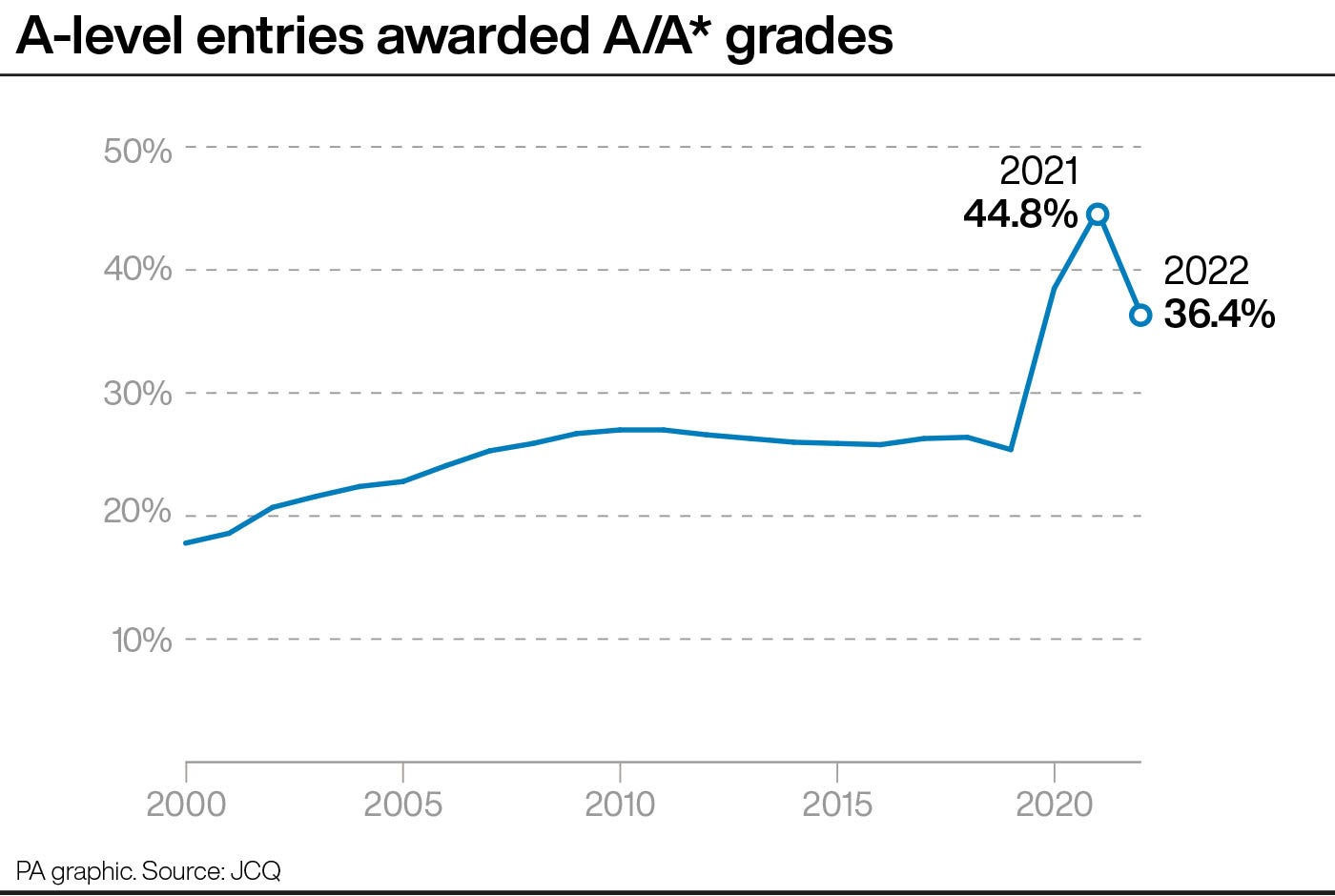
A-level results have dropped from last year - but are still higher than the last time students took exams.
Hundreds of thousands of pupils are finding out their marks in England, Wales and Northern Ireland on Thursday.
These pupils were the first to take A-level exams again after formal tests were cancelled for two years in a row during the Covid pandemic.
The overall pass rate has fallen to 98.4 per cent this year from 99.5 per cent in 2021, when grades were awarded by teachers.
But it has risen from the last time students sat A-level exams in 2019, when the proportion of entries awared A* to E grades was 97.6 per cent.
Entries receiving the top grades of A* and A are also down this year compared to 2021, falling from 44.8 per cent to 36.4 per cent.
But again, this has risen from the previous exam-sitting year, when 25.4 per cent of grades received the top marks.
The education secretary had warned students their grades may be lower than hoped or expected, as efforts to curb grade inflation came into force.

Exam boards were told to make grades lower than last year - when a record number of pupils got A grades or above - but still higher than before the Covid pandemic.
The figure for the highest A* grade fell to 14.6 per cent this year from 19.1 per cent in 2021, according to the Joint Council for Qualifications (JCQ), but was still higher than 7.7 per cent in 2019.
Meanwhile, the proportion of entries graded A* to C dropped from 88.5 per cent in 2021 to 82.6 per cent this year, though it is up from 75.9 per cent in 2019.

Girls continued to outperform boys overall, with A* to E grades at 98.7 per cent for the former, compared with 98.1 per cent for the latter, according to the JCQ.
“As intended, these results are higher than the last set of summer exams in 2019, but lower than last year’s teacher-assessed grades,” Kath Thomas from the JCQ said.
“This reflects the special arrangements that were put in place to support students, schools and colleges through another challenging year due to Covid.”

Dr Jo Saxton, the head of England’s exam regulator, said she “felt strongly that it would not have been right” to return to pre-pandemic grading levels in one go - but that there needed to movement “back to normality”.
The first cohort of students taking the new technical T-level qualification also received their results today, with the pass rate standing at around 92 per cent.
Many of these are moving onto their first job or an apprenticeship, while around a third have been placed onto a university course, according to the government.

Education unions have paid tribute to students and teachers who worked to achieve the grades after more than two years of disruption - which included GCSEs being cancelled for the cohort who took exams this year.
“These grades are a reflection of the circumstances in which exams were held and it would be wrong and wholly inaccurate to compare these results to previous years or make comparisons about performance in relation to previous pupil cohorts,” Dr Patrick Roach from the NASUWT-The Teachers’ Union said.
Geoff Barton from the Association for School and College Leaders said: “It is likely that results at the level of schools, colleges, and students will be uneven because of the highly variable impact of the pandemic with those affected more by infections potentially faring less well than others.”
He added: “This is not a normal year by any measure and it is important that we focus on supporting the progression of students rather than fixating too much on grades.”
A near-record number of students were accepted into their preferred or second-choice university on A-level results day.
Ucas said a total of 425,830 pupils received the grades they needed for their firm or insurance choice university - the second-highest figure to date after an all-time high in 2021.

Chris Hale, the chief executive of Universities UK, said: “It is exciting to once again see such high numbers of applicants continue their journey into higher education, confirming the strong appeal of our universities.”
He added: “Students applying this year have faced multiple years of disrupted education, and they and their families should be exceptionally proud of their achievements.”
Dr Tim Bradshaw, the chief executive of the selective Russell Group of universities, said: “It is fantastic to see the number of young people securing university places up on 2019, the last year exams were held, including from the most disadvantaged backgrounds.”
The number of students from the most disadvantaged backgrounds getting into university courses was around 3,000 higher this year compared to 2019, according to Ucas.
Dr Bradshaw said it had been a “competitive year for admissions” as things returned to normal after the Covid pandemic.
“Over the next few weeks our admissions teams will be working hard to place as many young people at our universities as possible, while making sure every student can receive the world class teaching and learning experience they rightly expect,” he said.
Here are the key statistics from this year’s A-level results:
- Proportion of A or A* grades is 36.4 per cent - down from 44.8 per cent in 2021 but up from 25.4 per cent in 2019.
- Just under 15 per cent received an A* - down from 19 per cent in 2021 but higher than around 8 per cent in 2019.
- Overall pass rate - grades A* to E - was 98.4 per cent, compared to 99.5 per cent in 2021 and 97.6 per cent in 2019.
- Around 83 per cent received a C or above. This was 88.5 per cent in 2021 and 76 per cent in 2019.
- The attainment gap between girls and boys has narrowed, with 37.4 per cent of girls getting top grades compared to 35.2 per cent of boys - a 2.2 percentage points difference. Last year, girls led boys by 4.8 percentage points.
- English literature saw the biggest drop in candidates for a single subject, falling by 9.4 per cent from last year.
- A total of 848,910 A-levels were awarded, up 2.9 per cent on last year’s 824,718.







